Conserving America’s Wetlands 2008:
Four Years of Partnering Resulted in
Accomplishing the President's Goal
Accomplishments
The President’s goal for wetlands has led the responsible federal agencies to focus their resources to achieve meaningful results. Agencies do this by
managing programs more strategically, leveraging resources, and partnering with others whenever possible. The following sections summarize accomplishments
planned for each of the three goal areas. Major contributing programs in FY 2009 are identified and highlighted. Wetland Reserve accomplishments reflect the
anticipated increase in the wetland enrollment acreage cap and mandatory funding under the new Farm Bill, assuming that all authorized acres are enrolled.
Restore or Create
After Four Years of Accomplishment: 1,197,000 acres
Estimated Accomplishment Earth Day 2009: 279,000 acres
(totals adjusted for double-counting)
Wetlands can be added by creating new wetlands or by restoring former wetlands lost to drainage or inundation. New wetlands are created in upland areas or deepwater sites. A gain in wetland acres may also be achieved by re-establishing former wetlands to restore functions and values approximating natural/historic conditions. Because of difficulties in establishing wetlands in upland areas, agencies have preferred to reestablish former wetlands when possible. In many cases, the necessary soils and seed stock still exist, and wetlands flourish once more as soon as the hydrology is restored.
During the first four years (April 2004 through April 2008), federal agencies reported restoring or creating 1,197,000 acres of new wetlands. By Earth Day
2009, federal agencies plan to restore or create an additional 279,000 acres of wetlands. During the first four years, 95 percent of the gains resulted from
re-establishing former wetlands, and five percent from establishing (i.e., creating new) wetlands (primarily on upland sites).
The federal government will restore wetlands in FY 2009 primarily through the Wetlands Reserve Program, North American Wetlands Conservation Act, Partners
for Fish and Wildlife Program, National Wildlife Refuge System, Conservation Reserve Program, and Conservation Technical Assistance Program (Figure 2).
Wetlands Reserve Program
This voluntary program provides technical and financial assistance to eligible landowners to address wetland, wildlife habitat, soil, water, and related
natural resource concerns on private lands. The program provides financial incentives for landowners to restore, protect, and enhance wetlands in exchange
for retiring marginal land from agriculture. Enrollment options include permanent easements, 30-year easements, and restoration cost-share agreements.
The Wetlands Reserve Program ( WRP) was reauthorized in the Farm Security and Rural Investment Act of 2002 (Farm Bill). The program is administered by NRCS and funded by the Commodity Credit Corporation. In FY 2007, NRCS state offices secured 379 easements on approximately 74,508 acres.
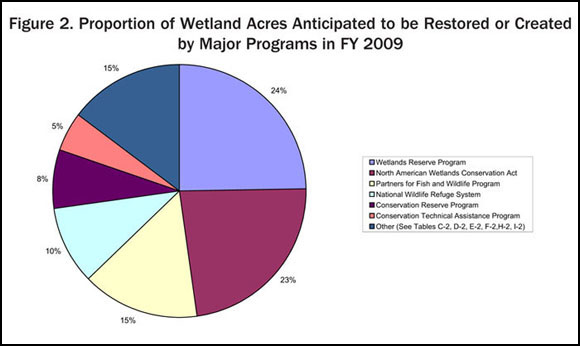
The types of wetlands restored by NRCS through this program vary, from floodplain forest to prairie potholes to coastal marshes. Historically, floodplain forest and associated sloughs and small emergent marsh wetlands account for approximately 65 percent of the program’s restoration activity. A majority of the enrolled floodplain acres offered into the program occur in areas subject to frequent flooding that were originally drained or cleared for agricultural production.
WRP expects to restore or create approximately 79,000 acres of wetlands in FY 2008 and 84,000 acres in FY 2009.
North American Wetlands Conservation Act
This FWS program promotes long-term conservation of North American wetland ecosystems for the benefit of waterfowl and other migratory birds, fish, and other
wildlife. Funds are provided by appropriations and by nonappropriated sources such as the Coastal Wetlands Planning, Protection and Restoration Act (CWPPRA);
interest earned on Pittman-Robertson Wildlife Restoration program funds; and fines collected under the Migratory Bird Treaty Act.
In FY 2007, NAWCA initiated the Sonoma Baylands Wetlands Restoration Project in California, a planned multi-phase program headed by the Sonoma Land Trust to protect and restore wetland and associated upland habitats in the north San Pablo Bay area of Sonoma County. The project will permanently protect 4,064 acres of wetland habitat via fee title acquisitions, and re-establish or rehabilitate a minimum of 1,019 acres of these acquired acres. The wetlands to be restored include estuarine and freshwater emergent and forested habitats. One of the primary restoration projects will occur on Sears Point, part of the San Pablo Bay National Wildlife Refuge, where the partners will restore tidal flows to 970 acres to re-establish estuarine intertidal wetlands and streams, rehabilitate 149 acres of palustrine wetland habitat, and link these wetlands to 2,000 acres of previously restored wetland habitat in the refuge.
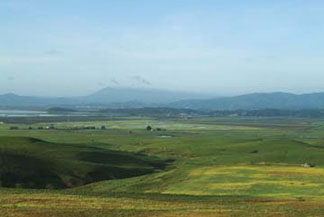 |
Six partners will restore tidal flows to 970 acres to re-establish estuarine intertidal wetlands and streams
and link these wetlands to 2,000 acres of previously restored wetland habitat on San Pablo Bay National Wildlife Refuge in Sonoma County, California.
This project was made possible by a NAWCA grant. (FWS) |
Six partners—including state and county agencies, conservation organizations, and a private foundation—are providing $9,722,000 in contributions to match the $1 million NAWCA grant. $941,750 of the NAWCA grant will be allocated to habitat restoration. The partnership’s protection and restoration plans will support other ongoing regional conservation efforts in Sonoma County and will improve habitat connectivity between completed and future wetland restoration projects.
NAWCA expects to restore or create approximately 79,000 acres of wetlands in FY 2008 and FY 2009.
Partners for Fish and Wildlife Program
The Partners for Fish and Wildlife Program is a popular and effective FWS program for voluntary and citizen-based wetlands restoration and enhancement
activities. The Partners program serves as a bridge to owners and managers of private lands to develop partnerships for improvement of fish and wildlife
populations and their habitats. Its approach is simple: engage willing partners, through nonregulatory incentives, to conserve and protect wildlife values on
their property. As the delivery mechanism for strategic habitat conservation, the Partners program staff coordinates with public and private partners to
reach national conservation goals. By working cooperatively with private landowners to restore and enhance habitat on private lands, the Partners program
helps reduce the reliance on regulation to achieve the FWS mission of conserving Trust species and keeping common species common.
The Partners for Fish and Wildlife Program in South Dakota restored three wetlands totaling 11.3 acres in association with a grassland seeding in a Conservation Reserve Program field. The wetland restorations were designed by a Partners’ biologist, and construction was completed by FWS personnel and equipment. This project is part of a decade-long partnership between USDA, Ducks Unlimited, and the Partners program to restore wetlands in Conservation Reserve Program(CRP) tracts. Over the past 10 years, this partnership has resulted in 406 restored wetlands totaling 1,339 acres. In addition, the Partners program is actively working with landowners to develop options for retaining CRP grasslands for grazing, as opposed to converting the grassland back to tillage agriculture. Upon expiration of a CRP contract, Partners’ biologists work closely with landowners to develop a grazing management plan for the area. The goal is to provide a suite of conservation practices and technical assistance to help landowners optimize rangeland health on expired CRP tracts.
The Partners program expects to restore or create approximately 51,000 acres of wetlands in FY 2008 and FY 2009.
National Wildlife Refuge System
The mission of the National Wildlife Refuge System, managed by FWS, is to administer a national network of lands and waters for the conservation, management,
and where appropriate, restoration of the fish, wildlife, and plant resources and their habitats within the United States for the benefit of present and
future generations of Americans. In Oregon, FWS and partners completed an 82-acre tidal marsh restoration project on Nestucca Bay National Wildlife Refuge in
the fall of 2007. The project site is located in the upper estuary along the Little Nestucca River and was composed of five private ownerships prior to
acquisition by the refuge. Over a century ago, this area was diked and drained, converting the marsh to pastures for dairy farms. The restoration project was
designed and implemented by the FWS, Ducks Unlimited, and the Confederated Tribes of the Siletz Indians. Partners contributing funds to the FWS for the
restoration included Ducks Unlimited, Oregon Watershed Enhancement Board, National Fish and Wildlife Foundation, Oregon Coastal Program, Pacific Coast Joint
Venture, James H. Stanard Family Foundation, The Nature Conservancy, and Tillamook People’s Utility District. Siuslaw National Forest, Oregon Department of
Fish and Wildlife, and William L. Finley National Wildlife Refuge provided inkind services and materials. A diverse assemblage of wildlife species including
migratory waterfowl, wading birds, and raptors are responding rapidly to the recovering intertidal habitats. Fish documented using the area since restoration
include juvenile coho and Chinook salmon, cutthroat trout, and other estuarine-dependent fish.
The NWRS anticipates restoring 34,000 acres of wetlands in FY 2008 and FY 2009 through re-establishing wetlands on former sites.
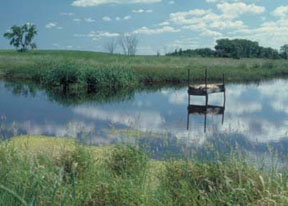 |
This wetland restoration project—in a focus area of the South
Dakota Partners for Fish and Wildlife Program—benefits high-priority migratory bird species. (FWS) |
Conservation Reserve Program
This USDA program restores wetlands, ranging from prairie potholes to floodplains to bottomland hardwood forest. Currently, one million acres of wetlands and 1.4 million acres of associated buffers are under long-term contracts. CRP wetland successes include partnerships with states through the Conservation Reserve Enhancement Program (CREP), which has enrolled over 87,000 acres of wetlands and associated buffers. In addition, in August 2004, President Bush announced the Non-Floodplain Wetland Restoration Initiative to encourage landowners to enroll 250,000 acres of large wetland prairie pothole complexes and playa lakes
located outside the 100-year floodplain. These wetlands provide important environmental benefits, including critical breeding habitat for ducks and grassland birds. Wildlife biologists at the Department of the Interior estimate that CRP efforts have resulted in a 30 percent increase in duck populations and
significant increases in grassland bird populations on CRP lands compared to cropland.
Other CRP wetland restoration initiatives include the prairie pothole duck nesting initiative and the constructed treatment wetlands implemented in the Iowa CREP. The duck nesting initiative, which began in 2006, provides for enrollment of up to 100,000 acres in prairie pothole lands targeted to wetland and surrounding nesting habitat. The Iowa CREP project creates wetlands in tile-drained cropland that remove nitrogen from the drainage water, while providing other wetland benefits.
The Conservation Reserve Program anticipates restoring or creating 17,000 acres of wetlands in FY 2008 and another 26,000 acres in FY 2009.
Conservation Technical Assistance Program
The broad purpose of NRCS’s Conservation Technical Assistance (CTA) Program is to help private landowners, conservation districts, tribes, and other
organizations by providing technical assistance through a national network of locally respected, technically skilled, professional conservationists. These
conservationists deliver consistent, science-based, site-specific solutions to help private landowners conserve, maintain, and improve the nation’s natural
resource base. The CTA Program provides the foundation for NRCS to assist farmers, ranchers, other landowners, local groups, tribes, and local governments to
plan and implement natural resource conservation systems.
In FY 2007, CTA was the major source of technical assistance for planning and applying conservation practices and systems to conserve and enhance natural resources on non-federal land. These conservation actions delivered public benefits in the form of better soil quality, reduced delivery of sediment and nutrients to surface and ground waters, increased conservation of water supplies, healthier grazing and forest land ecosystems, diverse and healthier wildlife habitat, and improved wetlands condition and function.
An example of the success NRCS has attained in creatingand re-establishing wetlands is the construction of duck wing shaped terraces in Jefferson Parish, Louisiana. In 2007, the CTA Program partnered with Ducks Unlimited, Louisiana Department of Natural Resources, Crescent Soil and Water Conservation District, Barataria-Terrebonne National Estuary Program, Louisiana State University Extension Service, and Jefferson Parish local government to plan, design, construct, and vegetate 18,750 linear feet of earthen terraces in Jefferson Parish, Louisiana. The terraces were constructed 2.5 miles south of Lafitte, Louisiana, along Barataria Waterway east and west of Dupree Cut. Thirty-six duck wing terraces averaging 500 linear feet were constructed to calm wind effect in open water areas, to re-establish submersed aquatic vegetation to restore wetlands, and to reduce erosion along adjacent shorelines. Existing berms and levees were repaired to maintain adequate water levels in the project area. This wetland restoration project also enhanced a total 5,437.5 acres of intermediate to brackish coastal marsh, thus benefiting a diverse array of migratory birds and other wildlife in the area.
The Conservation Technical Assistance Program expects to restore or create approximately 17,000 acres of wetlands in FY 2008 and FY 2009.
Improve Wetlands
After Four Years of Accomplishment: 1,079,000 acres
Estimated Accomplishment Earth Day 2009: 238,000 acres
(totals adjusted for double-counting)
Some degraded wetlands do not function properly because of past or present stressors. Agencies can improve wetlands by modifying the physical, chemical, or biological characteristics of a degraded wetland site with the goal of repairing its natural/historic functions and associated values(referred to as rehabilitation). They also can modify the physical, chemical, or biological site characteristics to heighten, intensify, or improve specific functions or to change the growth stage or composition of vegetation. These actions are taken with a specific goal in mind, such as improving water quality, floodwater retention, or wildlife habitat. This type of improvement, called enhancement, results in a change in wetland functions and associated values, may lead to a decline in other wetland functions and values, and does not result in a gain in wetland acres.
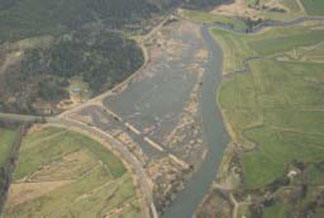 |
At the Nestucca Bay National Wildlife Refuge in Oregon, the FWS
worked with multiple federal, state, tribal, and local agencies, as well as with conservation groups and a private foundation, to remove dikes and
thereby restore 82 acres of estuarine wetlands benefiting migratory birds, salmon,
and other species. (FWS) |
During the first four years (April 2004 through April 2008), federal agencies reported improving the quality of 1,079,000 acres of existing wetlands. By Earth Day 2009, federal agencies plan to improve an additional 238,000 acres of wetlands. During the first four years, 86 percent of the gains in wetland quality resulted from enhancing specific functions and values of degraded or fully functioning wetlands and 14 percent of the gains resulted from rehabilitating the natural/historic functions and associated values of degraded wetlands.
The major programs that are planning FY 2009 wetland improvements include the National Wildlife Refuge System; North American Wetlands Conservation Act; Conservation Technical Assistance Program; Coastal Wetlands Planning, Protection and Restoration Act; Aquatic Ecosystem Restoration Program; North American Waterfowl and Management Plan–Joint Ventures; and National Estuary Program (Figure 3).
National Wildlife Refuge System
The National Wildlife Refuge System rehabilitates or enhances wetlands to provide quality habitat for wildlife. When Hurricane Isabel hit in 2003, its winds
destroyed most of the remnant stands of mature Atlantic white cedar in the Great Dismal Swamp NWR in southeastern Virginia and northeastern North Carolina.
An FWS forester and other refuge staff have worked to bring back some of the lost forest. A helicopter company is removing the damaged trees, while leaving
standing trees to produce seed. This makes room for naturally regenerating seedlings to sprout and thrive. To augment natural regeneration, especially in
some areas affected by the record-breaking drought of 2007, seedlings grown from seeds collected in the refuge will be planted.
Atlantic white cedar forests are a globally rare community type. The Atlantic white cedar wetlands at Great Dismal Swamp NWR provide habitat for the rare Hessel’s hairstreak and the declining black-throated green warbler (Wayne’s race). Historically, enslaved laborers harvested the durable cedar in the Great Dismal Swamp and cut it into roof shingles and barrel staves. The cathedral-like stands reminiscent of diminutive redwood forests will be reestablished for the enjoyment of future generations through this project, which will rehabilitate more than 900 acres of the damaged wetlands.
The National Wildlife Refuge System expects to rehabilitate or enhance approximately 112,000 acres of wetlands on refuges throughout the United States in FY 2008 and FY 2009.
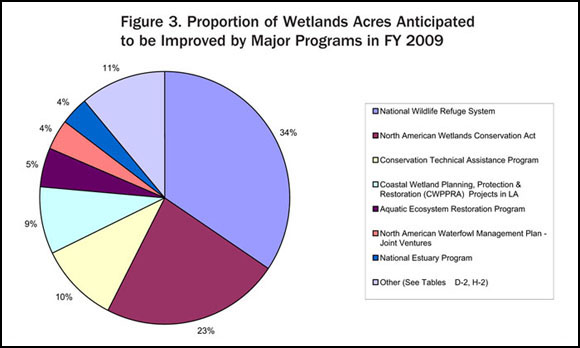
North American Wetlands Conservation Act
The FWS awards NAWCA grants to improvement projects that modify a functioning wetland ecosystem to provide additional long-term wetland conservation
benefits. For example, Phase III of the Great Salt Lake Wetlands Project represents the long-term effort to conserve wetlands and promote wetland-dependent
migratory bird populations within the Great Salt Lake watershed. This project focuses on the enhancement of 10,842 acres of wetlands immediately associated
with and adjacent to the Great Salt Lake. One of the most pressing wetland conservation needs is the immediate control of widespread infestations of invasive
species, particularly common reed (Phragmites australis) and carp (Cyprinus carpio). This proposal includes a diverse partnership working to improve wetland
habitat and local breeding populations of waterfowl, shorebirds, and other waterbirds by controlling these invasive species. Twelve partners - including
federal and state agencies, conservation organizations, private landowners, and corporations - are providing $873,686 to match the $932,178 NAWCA grant. The
landowners and managers included in this proposal are currently investing in substantial chemical control of common reed. NAWCA grant funding will be almost
entirely dedicated to the installation of physical improvements to habitat management infrastructure that will allow for long-term control of invasive
species. These will include fish barrier structures to exclude carp, reconstruction of failing dikes and water control structures, construction of new
sub-dikes for improved water management, and rehabilitating outlet channels to improve water management capabilities.
NAWCA expects to improve approximately 75,000 acres of wetlands in FY 2008 and FY 2009.
 |
At the Great Salt Lake in Utah, NAWCA removed common reed (Phragmites) and carp to improve habitat for
waterfowl and shorebirds at the Farmington Bay Wildlife Management Area. (FWS) |
Conservation Technical Assistance Program
The NRCS Conservation Technical Assistance Program continues to be the major source of technical assistance for planning and applying conservation practices
and systems to conserve and enhance natural resources on nonfederal land. These conservation actions deliver public benefits in the form of better soil
quality, reduced delivery of sediment and nutrients to surface and ground waters, increased conservation of water supplies, healthier grazing and forest land
ecosystems, diverse and healthier wildlife habitat, and improved wetlands condition and function.
The Conservation Technical Assistance Program expects to improve approximately 34,000 acres of wetlands in FY 2008 and FY 2009.
Coastal Wetlands Planning, Protection and Restoration Act (CWPPRA) Projects in Louisiana
The Coastal Wetlands Planning, Protection and Restoration Act program restores and enhances coastal wetlands in coastal states. Construction of the Goose
Point/Point Platte Marsh re-establishment and enhancement project started in spring 2008. It is being sponsored by the Fish and Wildlife Service and the
Louisiana Department of Natural Resources. Located along the northern shoreline of Lake Pontchartrain, north of the city of New Orleans, the project will
enhance 593 acres of wetland habitat and re-establish an additional 551 acres. It also will preserve the integrity of the northern Lake Pontchartrain
shoreline, thereby preventing the lake from breaching into fragile interior marshes and ponds. The total project cost is $20.9 million.
Louisiana CWPPRA projects are expected to improve approximately 2,000 acres in FY 2008 and 28,000 acres in FY 2009.
Aquatic Ecosystem Restoration Program
The U.S. Army Corps of Engineers uses both projectspecific and programmatic authorities for implementing aquatic ecosystem restoration projects. One of these
projects—the Seminole Big Cypress Water Conservation Project in Florida—will provide important benefits to the Big Cypress Swamp. The freshwaters of the Big
Cypress Swamp are essential to the health of the neighboring Everglades, and they support the rich marine estuaries along Florida’s southwest coast.
Protecting more than 720,000 acres of this vast swamp, Big Cypress National Preserve contains a mixture of tropical and temperate plant communities that are
home to a diversity of wildlife, including the elusive Florida panther.
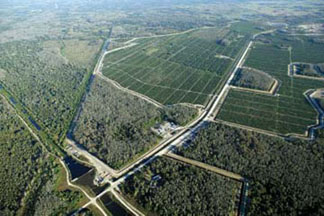 |
The USACE water retention area and feeder canal of the Seminole
Big Cypress Water Conservation Project will enhance the quality of water in the 52,000-acre Big Cypress Reservation of the Seminole Tribe in Florida
and nearby Big Cypress National Reserve and Everglades. The project will also improve wetlands by returning more natural hydroperiods. (USACE)
|
When completed, the Seminole Big Cypress Water Conservation Project will contribute to the reinstatement of a more natural hydroperiod over much of the 52,160-acre Big Cypress Reservation and enhance the quality of water entering the Big Cypress National Preserve to the south, as well as other adjacent properties. The project also calls for the creation of additional wetlands to replace some losses of this South Florida critical habitat and enhancement of uplands, which also support many threatened and endangered species. As a result of these hydrologic modifications, habitat diversity will be enhanced throughout the entire region. It will allow opportunities for better control of water, enhancement of environmental features, and improvement of the reservation lands and future land use by the Seminole Tribe.
A minimum of 14,000 acres of existing wetlands will be enhanced by the reinstatement of a more natural hydrologic regime. In addition, a total of 205 acres of poor-quality uplands, which are currently in pasture, will be transitioned to functioning wetland habitat. The establishment of water retention cells totaling 656 acres will aid in control of flooding throughout the Reservation and provide much-needed water for irrigation during periods of drought.
This project is designed to improve the quality of water and runoff from all phosphorus-generating agricultural sources within the reservation. A phosphorus level of 50 ppb is the goal, which is the current performance level designed for the stormwater treatment areas. Should design performance levels for phosphorus become more stringent, the project is designed to incorporate additional alternative technology to meet stricter levels.
The Aquatic Ecosystem Restoration Program expects to improve approximately 2,000 acres of wetlands in FY 2008 and 16,000 acres in FY 2009.
North American Waterfowl Management Plan - Joint Ventures
This tri-national strategic plan fosters the creation of partnerships between the federal government, states, tribes, corporations, private organizations,
and individuals to cooperate in the planning, funding, and implementation of projects to conserve and enhance wetland habitat in high-priority “joint
venture” regions.
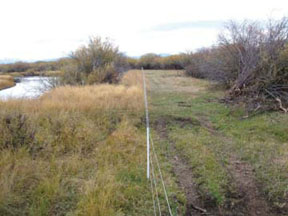 |
The Intermountain West Joint Venture, composed of multiple partners under the North American Waterfowl
Management Plan, worked with ranchers to install 12 miles of wildlife-friendly fencing to improve 1,200 acres of riparian wetlands along the Big Hole
River in Montana. (FWS) |
The Intermountain West Joint Venture provided project funding and coordination assistance to incorporate strategic bird habitat conservation into a watershed-based effort to restore fluvial arctic grayling in the Big Hole Valley of southwest Montana. The McDowell Reach Riparian Restoration Project improved 1,200 acres of riparian wetlands along the Big Hole River through 12 miles of wildlife-friendly riparian fencing and other rehabilitation activities. The project was the centerpiece of a larger initiative of federal, state, non-profit, and private partners to restore and protect critical habitats throughout the watershed in a manner that benefits the livestock operations of the Valley’s ranching families.
Joint Ventures expect to improve approximately 16,000 acres of wetlands in FY 2008 and 13,000 acres in FY 2009.
Protect Wetlands
After Four Years of Accomplishment: 1,324,000 acres
Estimated Accomplishment Earth Day 2009: 376,000 acres
(totals adjusted for double-counting)
Priority wetlands are protected from activities that may imperil their existence or condition. In this report, protection refers to acquisition of land or easements of at least 30 years. Because protection maintains the base of existing wetlands, it does not result in a gain of wetland acres or function.
During the first four years (April 2004 through April 2008), federal agencies reported protecting 1,324,000 acres of existing wetlands. By Earth Day 2009, federal agencies plan to protect an additional 376,000 acres of wetlands.
The major programs planning wetland protection in FY 2009 are the North American Wetlands Conservation Act, Wetlands Reserve Program, National Estuary Program, and National Wildlife Refuge System’s Migratory Bird Conservation Fund program (Figure 4).
North American Wetlands Conservation Act
NAWCA projects often involve partnerships of state and local governments and nongovernmental and private organizations seeking to acquire wetland habitat.
These acquisitions may be incorporated into the FWS National Wildlife Refuge System or into a state’s protected area system, or they may be included in
holdings protected by a nonprofit conservation organization (e.g., The Nature Conservancy).
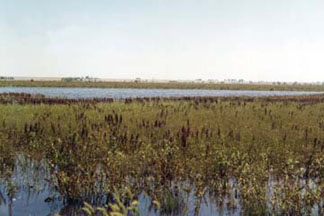 |
A NAWCA grant, matched by a local Chamber of Commerce, will acquire and protect at
least 3,000 core acres of historic Drummond Flat in Oklahoma (at the confluence of the Turkey, Elm, and Salt Creeks) for management by the Oklahoma
Department of Wildlife Conservation. (FWS) |
One such project is the historic Drummond Flat in Garfield County, Oklahoma. It is in the first of at least four phases to acquire, restore, and subsequently manage a total of 7,000 acres of historical freshwater vegetated wetlands and wetland-associated uplands. Seventeen partners—includingfederal, state, and local government agencies; conservation organizations; private landowners; corporations; and a local Chamber of Commerce—are providing $1,407,482 to match the $700,000 NAWCA grant. The core area of this proposal is at the confluence of three watershed drainages—Turkey, Elm, and Salt creeks. Historically, this low-lying area maintained standing water for long periods through the spring and summer. The work in this initial phase involves the acquisition and protection of at least 3,000 core acres of Drummond Flat by the Oklahoma Department of Wildlife Conservation for future use as a wildlife management area. Acquisition of these core wetlands will enable future acquisition actions and set the stage for the restoration of historic wetland values in a region where limited habitat is heavily used by migratory waterfowl, shorebirds, and wading birds and other wildlife.
NAWCA expects to protect approximately 227,000 acres of wetlands in FY 2008 and FY 2009.
Wetlands Reserve Program (WRP)
NRCS is especially proud of the partnership efforts that have been generated as a result of this program’s activities. Restoration of two Wetlands Reserve
Program easements in 2007 owned by Twin Oaks Land Company in Winnebago County, Iowa, have not only restored and enhanced wetlands and wildlife to the local
area, but are serving as a water quality filter for area farmers. The easements, totaling over 300 acres, comprise nearly 120 acres of wetland soils that
have been restored and/or enhanced. Of those acres, 50 acres will offer a natural filter to six drainage tile lines. The lines were brought to the surface so
the wetlands could filter out any sediments, nutrients, and contaminants from surrounding farmland before entering the drainage system downstream.
The Wetlands Reserve Program expects to protect approximately 100,000 acres of wetlands in FY 2008 and an additional 122,000 acres in FY 2009.
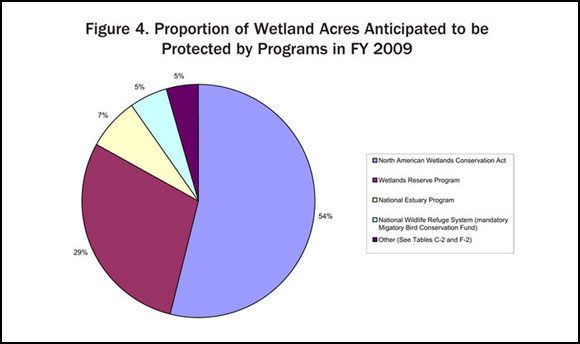
National Estuary Program
At the 28 National Estuary Program (NEP) sites around the country, local stakeholders work together to identify and prioritize the problems in their
estuaries. NEP community stakeholders include citizens; educators; government representatives at the state, local, and federal levels; environmental
advocates; business leaders; scientists; farmers; and people who fish. Each community develops and implements a Comprehensive Conservation and Management
Plan with specific actions designed to protect the estuary and its resources. The plan addresses all aspects of environmental conservation for the estuary,
including water quality, habitat, living resources, and land use practices, which leads to restoration/creation, improvement, and protection activities
including land protection and acquisition projects.
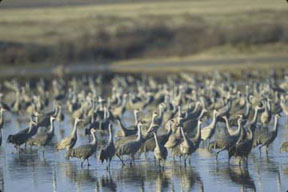 |
EPA’s National Estuary Program worked with partners to purchase 61 acres of McAllis
Point marsh, part of a larger wetland protection and conservation project in West Galveston Bay, Texas, for use by sandhill cranes, such as these.
(FWS) |
For example, the Galveston Bay Estuary Program and several partners joined together to purchase 61 acres along a 1,850-foot-wide parcel that fronts on West Galveston Bay. The land is located roughly three-quarters of the way down the length of Galveston Island, a 32-mile barrier island about three miles off the Texas mainland at McAllis Point. McAllis Point is one of the last undisturbed, large prairie and marsh habitats left on Galveston Island’s West End. Its conservation ensures the preservation of the various habitats found on the Island, and offers refuge for wildlife and a variety of bird species, including the sandhill crane, which roosts in Galveston’s remaining prairie areas from November to March. The conserved portion of the site will be open to the public as a nature preserve. The overall project—combined with recently completed wetland restoration/protection efforts at Delehide Cove, Jumbile Cove, and the Galveston Island State Park—will help preserve the integrity of the entire marsh ecosystem along the southern shoreline of West Bay. The Galveston Bay Estuary Program, one of the original 28 NEPs established in 1989, guides the conservation and restoration of Texas’ largest estuary. The Galveston Bay Estuary Program is committed to preserving Galveston Bay for generations to come.
NEP expects to protect approximately 30,000 acres of wetlands in FY 2008 and FY 2009.
National Wildlife Refuge System (Migratory Bird Conservation Fund Program)
The FWS Migratory Bird Conservation Fund program acquires wetlands and associated habitats from willing sellers to benefit waterfowl species and other
migratory birds most in need of habitat protection. FWS focuses its efforts on migratory bird breeding areas, resting places, and wintering areas under the
authority of the Migratory Bird Conservation Act and the Migratory Bird Hunting and Conservation Stamp Act (“Duck Stamp Act”). Many of the lands and
interests acquired are small natural wetlands located in the Prairie Pothole region of the Upper Midwest and northern Great Plains portion of the Central
Flyway. Wetlands and migratory bird habitats located within the Atlantic, Mississippi, and Pacific Flyways are also targeted.
A recent acquisition in Monroe County, Arkansas, added 226 acres to the White River National Wildlife Refuge, thereby permanently protecting these acres. The Refuge was authorized in 1935 as a refuge and breeding ground for migratory birds and other wildlife. It is located within the White River floodplain near where it meets the Mississippi River, and is one of the largest remaining bottomland hardwood forests in the Mississippi River Valley. One of the refuge’s primary purposes is to preserve and protect habitat for wintering waterfowl, including the mallard, gadwall, and green-winged teal.
Migratory Bird Conservation Funds are expected to protect approximately 17,000 acres of wetlands in FY 2008 and 22,000 acres of wetlands in FY 2009.
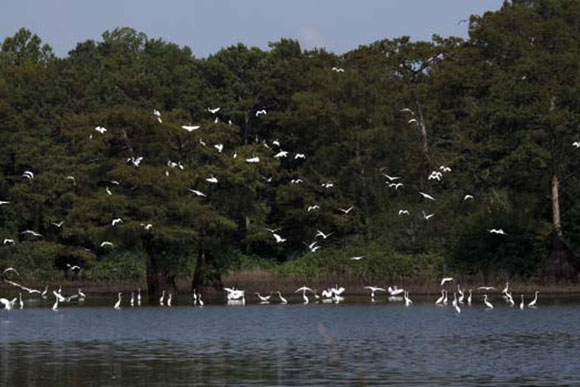 |
Wetlands acquired from willing sellers in Arkansas for White River NWR include 226
acres of bottomland hardwoods and cypress-lined lakes that provide habitats for migratory birds year-round. (FWS) |










